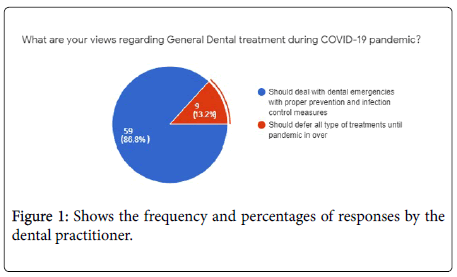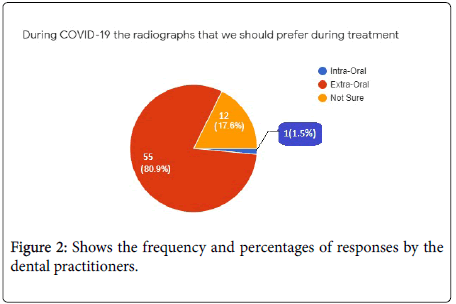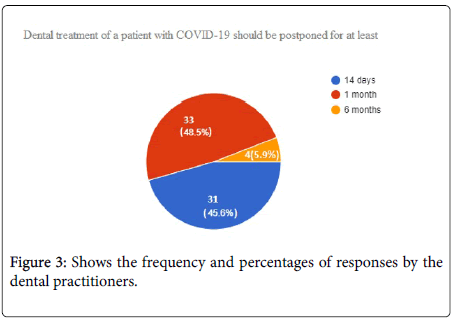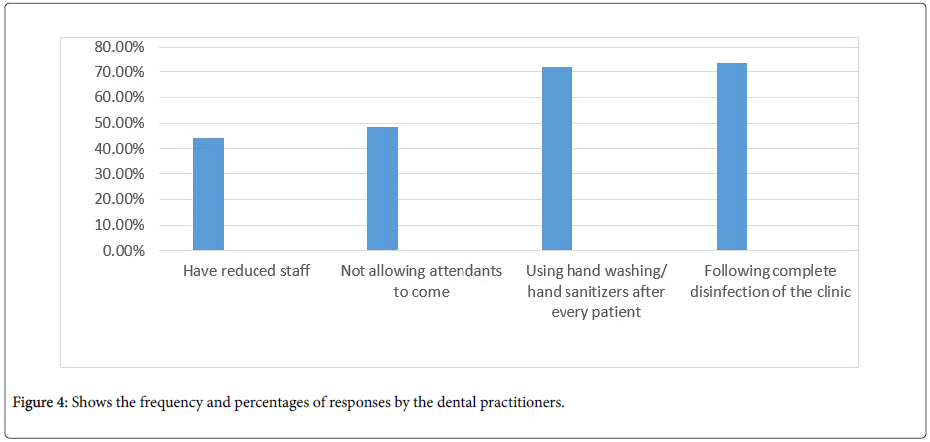Awareness and Attitude of Dental Practitioners towards COVID-19
Received: 23-Apr-2020 / Accepted Date: 07-May-2020 / Published Date: 14-May-2020 DOI: 10.4172/2332-0702.1000257
Abstract
Aim: The purpose of this study was to evaluate the awareness and attitude of dental practitioners towards COVID-19 while providing dental treatment.
Introduction: Observational cross sectional study.Oral and maxillofacial surgery department, PMC Dental Institute Faisalabad Medical University, Faisalabad.
Materials and methods: Questionnaire was developed by dental experts and literature search and was shared by google docs. The data was collected on specially designed Performa. The data of the registered dental practitioners of the Punjab region as acquired from PM&DC database. The practitioners were given a reminder call to submit the Performa.
Results: From overall 68 participants, 83.8% had view to defer dental treatment in incubation period, 88.2% thought that our standard protocols are inefficient. Only 25.0% had knowledge that infection couldn’t transfer through sharp instrument impact. Those who voted for transfer between mucous membrane and contaminated hands were 94.1%. The 98.5% percent said that hand hygiene is not sufficient to prevent spread, so some of them were using more precautions. The 73.5% opted for treatment by using goggles, specific respirators and PPEs. Some of the practitioners following pre check measures are (88.2%) and those who said rinsing reduces microbial load are 89.7%. The 20.6% believed that it is of group B and 80.9% thought they should use protection level as of group A. 86.8% participants agreed on dealing with only dental emergencies during pandemic.
Conclusion: According to this study most of the dental practitioners are unaware of exact protection protocols and health authorities should take aggressive steps in educating the dental practitioners for infection control management related to COVID-19.
Keywords: Awareness; Dental Practitioners; Attitude; COVID-19
Aim
The purpose of this study was to evaluate the awareness and attitude of dental practitioners towards COVID-19 while providing dental treatment.
Introduction
The novel corona virus that has its origin from Wuhan, China with its first patient presented in last December and now had become a major health challenge not only for china but also for all the countries around the word. The World health organization on January 30, 2020 declared this outbreak as major health emergency of international concern [1]. As of April 07, COVID-19 the cases presented worldwide with total 1,279,722 confirmed cases and 72,614 deaths (WHO). The Chinese Center of Disease control and prevention has announced that the causative agent of COVID-19 is novel coronavirus.
The common transmission routes of novel coronavirus include direct transmission (cough, sneeze, and droplet inhalation) and contact transmission (contact with oral, nasal, and eye mucous membranes). Although eye symptoms are not present, eye exposure is an effective way for the virus to spread in the body suggesting COVID-19 transmission is not limited to the respiratory tract only [2- 5].
The participants in dental practice are exposed to the highest risk of infection due to direct exposure and close contact to saliva, blood and other body fluids. In countries that are highly affected with coronavirus, a strict and effective infection control is required for dental practitioners to work in hospitalsdental offices [2]. The aerosols that are produced during dental treatment due to high powered devices like hand piece and ultrasonic scalers have significant potential for disease transmission to clinicians, staff and patients [1,6].
There is increased risk of cross infection between hospital staff, practitioners and patients during a dental setting. The aerosols produced by dental equipment’s has fourfold increase of bacteria along with blood that can float/remain suspended in air for a considerable time before settling down thus increasing the chances of inhalation by dental staff and other patients. Oral bacteria can spread by aerosols up to two meters from field of procedure [7-9]. Studies have proven that dental practitioners are more prone to respiratory diseases and increased level of anti-bodies to Legionella pneumophila [10]. When ultrasonic scalers are used in combination with water spray they result in aerosols containing blood, saliva, tooth debris, dental plaque, calculus and restorative material, thus imposing the highest risk of infection due to direct exposure to saliva, blood and other body fluids [7,11].
The rationale of this study was to assess the level of awareness of the dental practitioners about COVID-19 and their attitude while providing dental treatment and the various methods that they are adopting to limit spread of infection in their respective practices.
Materials and Methods
After seeking approval from ERC, the questionnaire was developed by a team of dental experts and infection control specialists after doing a thorough literature research and formal discussions. The participants meeting the criteria were included in the study. The data was collected on specially designed Performa. The data of the registered dental practitioners of the Punjab region as acquired from PM&DC database. The questionnaire was developed electronically using Google docs and a link was shared with dental practitioners using mobile phones/emails and they were asked to fill the form online and submit it to the principal investigator, maintaining their confidentiality.
Results
The questionnaire was sent to 140 dental practitioners and out of them 68 responded to the form. The overall response rate to the questionnaire was 48.57%. The questionnaire consisted of total fifteen (15) questions out of which fourteen were of single check points and one question was of multiple check points. The frequency and percentages of the responses are given in (Tables 1 and 2).
| Questions | Frequency % age | ||
|---|---|---|---|
| Yes | No | Not sure | |
| Do you think Dental treatment can be provided when the patient is in incubation period? | 7(10.3%) | 57 (83.8%) | 04(5.9%) |
| Do you think our standard daily protocols are sufficient to combat COVID-19? | 5 (7.4%) | 60 (88.2%) | 3 (4.4%) |
| Do you think infection can spread through puncture of sharp instruments? | 43 (63.2%) | 17(25.0%) | 8(11.8%) |
| Do you think the infection can spread through direct contact between mucous membrane and contaminated hands? | 64(94.1%) | 2(2.9%) | 2(2.9%) |
| Hand hygiene alone is sufficient in dental office for prevention of Novel COVID-19? | 0(0.0%) | 67(98.5%) | 1(1.5%) |
| As respiratory droplets are the main source of spread, can the dental treatment be provided by using PPE, goggles, gloves and particulate respirators? | 50(73.5%) | 13(19.1%) | 5(7.4%) |
| During COVID-19, pre-check measures of staff, patients, and Dentist should be continued | 60(88.2%) | 8(11.8%) | 0 (0.0%) |
| Pre-operative anti-microbial mouth rinses can reduce load of microbes in oral cavity? | 61(89.7%) | 5(7.4%) | 2(2.9%) |
| Have you taken any course or training to deal with corona pandemic? | 22(32.4%) | 44(64.7%) | 2(2.9%) |
Table 1: Showing frequency and percentages of responses by the dental practitioner.
Questions |
Frequency/percentage |
|
|---|---|---|
| Group A | Group B | |
| Novel COVID-19 belongs to infectious group | 54(79.4%) | 14(20.6%) |
| For COVID-19 we should use protection level as of used for | 55(80.9%) | 13(19.1%) |
Table 2: Showing frequency and percentages of responses by the dental practitioner.
Dentist who were of the opinion that we should only deal with dental emergencies during this pandemic are 86.8% and 13.2% thought we have to postpone all the dental treatments until this is over as shown (Figure 1).
The 80.9% participants were in the favor of extra-oral radiographs, 1.5% voted for intra-oral while 17.6% were not sure as shown in (Figure 2).
People recovering from Novel Covid-19 should have no dental treatment for at least one month is the opinion of 48.5% of the participants, 45.6% believe to defer for fourteen days and 5.9% wantto postpone for six months (Figure 3).
Some of the practitioners were taking more than one special precautions for which data been displayed in (Figure 4).
Discussion
The coronavirus disease is an enveloped RNA viruses characterized by club like spikes that project from the surface. COVID-19 is infectious disease that has spread globally causing cough, fever, shortness of breath and other symptoms like muscle pain, diarrhea, sore throat, loss of smell and abdominal pain. Different publications are going on around the world on the spread, prevention and treatment to coronavirus disease.
In this study the dental practitioners who were performing dental procedures at their clinics and the protocols they have adopted for prevention, and their awareness and knowledge about the current pandemics of COVID-19 has been assessed. As a clinician, 83.8% were of the view that dental treatment cannot be executed while the patient is in incubation period. This is in agreement with other studies like Meng et al. [1]. Dental treatment should not be provided while the patient is in incubation period. Overall 88.2% participants were sure that our standard daily protocols are insufficient to combat COVID-19. The treatment to patients should be provided only by using infection controls measures recommended for corona [1,12]. The study revealed that 63.2% agreed on infection transfer through sharp instruments but according to advance transfusion and cellular therapies, coronavirus does not spread by puncture of sharp instruments. Another finding of this study shows 94.1% participants voted for spread of infection through direct contact between mucous membrane and contaminated hands which is also highlighted by KK et al. and others [13,14].
Ninety eight percent participants believed that only hand hygiene is not sufficient to prevent spread of infection which is in agreement with Peng et al. [2]. As the respiratory droplets are the main source of spread, so 73.5% opted for the treatment by using PPEs, specific respirators and goggles [1,12].The dentists who preferred pre-check measures at their clinics are 88.2% which is in correspondence with report of WHO-China joint mission on coronavirus disease 2019. Participants who said that preoperative oral rinsing reduces microbial load were 89.7% as proven by Swaminathan et al. [15,16]. The respondents who had taken a formal course related to COVID-19 management are only 32.4%, but according to Coulthard et al. [17] all the health care professionals should take the course.
According to this study only 20.6% of the practitioners had knowledge that coronavirus belonged to group B and 80.9% were following sterilization protocols as of group A [1]. 86.8% of the dentist were in favor to deal with dental emergencies only and 80.6% opted for extra-oral radiographs [18]. According to this study 48.5% of the participants voted to defer dental treatment for 1 month for all those who recovered from COVID-19. In response to the last question, 44.1% dentists stated that they have reduced their staff members to minimum numbers to deal with emergency procedures. Moreover 48.5% also stated that they are not allowing attendants of the patients to enter the operatory room in order to maintain the social distancing. Majority, 72.1% of them were using hand disinfectants and 73.5% were performing disinfection of surgeries after procedure [19]. There were following limitations of this like we don’t know the procedures they were performing at their clinics and this is a data from only 68 dental practitioners thus a large data may present different results.
Conclusion
Within the limits of this study we concluded that most of the dental practitioners were unaware of exact protection protocols of COVID-19 while providing treatment. Only a small percentage of practitioners are taking courses for COVID-19. Health authorities should take aggressive steps in educating the dental practitioners for infection control management related to COVID-19.
References
- Meng L, Hua F, Bian Z (2020) Coronavirus disease 2019 (COVID-19): Emerging and future challenges for Dental and Oral Medicine. J Dent Res 99: 481-487.
- Peng X, Xu X, Li Y, Cheng L, Zhou X, et al. (2020) Transmission routes of 2019-nCoV and controls in dental practice. Int J Oral Sci 12: 1-6.
- Huang C, Wang Y, Li X, Ren L, Zhao J, et al. (2020) Clinical features of patients infected with 2019 novel coronavirus. The lancet 395: 497-506.
- Lu CW, Liu XF, Jia ZF (2020) 2019-nCoV transmission through the ocular surface must not be ignored. Lancet 395: e39.
- Otter JA, Donskey C, Yezli S, Douthwaite S, Goldenberg SD, et al. (2016) Transmission of SARS and MERS coronaviruses and influenza virus in healthcare settings: the possible role of dry surface contamination. J Hosp Infect 92: 235-250.
- Cleveland JL, Gray SK, Harte JA, Robison VA, Moorman AC, et al. (2016) Transmission of blood-borne pathogens in US dental health care settings: 2016 update. J Am Dent Assoc 147: 729-738.
- Harrel SK, Molinari J (2004) Aerosols and splatter in dentistry: a brief review of the literature and infection control implications. J Am Dent Assoc 135: 429-437.
- Wei J, Li Y (2016) Airborne spread of infectious agents in the indoor environment. Am J Infect Control 44: S102-108.
- Samaranayake LP, Reid J, Evans D (1989) The efficacy of rubber dam isolation in reducing atmospheric bacterial contamination. ASDC J Dent Child 56: 442-444.
- Kevorkyan A, Tomova I, Raycheva R, Stoeva V, Stoilova Y, et al. (2017) Legionella pneumophila antibodies in serum samples from medical and dental personnel: a seroepidemiological survey. Biotechnol Equip 31: 588-593.
- Sawhney A, Venugopal S, Babu GR, Garg A, Mathew M, et al. (2015) Aerosols how dangerous they are in clinical practice. J ClinDiagn Res 9: ZC52- ZC57.
- Wax RS, Christian MD (2020) Practical recommendations for critical care and anesthesiology teams caring for novel coronavirus (2019-nCoV) patients. Can J Anesth 67: 568-576.
- To KK, Tsang OT, Yip CC, Chan KH, Wu TC, et al. (2020) Consistent detection of 2019 novel coronavirus in saliva. Clin Infect Dis pii: ciaa149.
- Liu L, Wei Q, Alvarez X, Wang H, Du Y, et al. (2011) Epithelial cells lining salivary gland ducts are early target cells of severe acute respiratory syndrome coronavirus infection in the upper respiratory tracts of rhesus macaques. J virol 85: 4025-4030.
- Swaminathan YO, Toby Thomas J, Muralidharan NP (2014) The efficacy of preprocedural mouth rinse of 0.2% chlorhexidine and commercially available herbal mouth containing salvadorapersica in reducing the bacterial load in saliva and aerosol produced during scaling. Asian J Pharm Clin Res 7: 71-74.
- Akande OO, Alada AR, Aderinokun GA, Ige AO (2004) Efficacy of different brands of mouth rinses on oral bacterial load count in healthy adults. Afr J Biomed Res 7: 125-128.
- Coulthard P (2020) Dentistry and coronavirus (COVID-19)-moral decision-making. Br Dent J 228: 503-505.
- Ather A, Patel B, Ruparel NB, Diogenes A, Hargreaves KM, et al. (2020) Coronavirus Disease 19 (COVID-19): Implications for clinical dental care. J Endod 46: 584-595.
- Alharbi A, Alharbi S, Alqaidi S (2020) Guidelines for dental care provision during the COVID-19 pandemic. Saudi Dent J 32: 181-186.
Citation: Hammad M, Janjua OS, Ashraf W, Zafar KJ, Khan MS, et al. (2020) Awareness and Attitude of Dental Practitioners towards COVID-19. J Oral Hyg Health 8: 257. DOI: 10.4172/2332-0702.1000257
Copyright: © 2020 Hammad M, et al. This is an open-access article distributed under the terms of the Creative Commons Attribution License, which permits unrestricted use, distribution, and reproduction in any medium, provided the original author and source are credited.
Share This Article
Recommended Journals
Open Access Journals
Article Tools
Article Usage
- Total views: 2198
- [From(publication date): 0-2020 - Aug 17, 2024]
- Breakdown by view type
- HTML page views: 1608
- PDF downloads: 590




